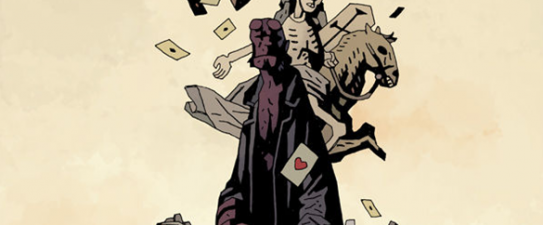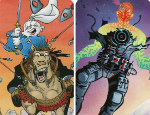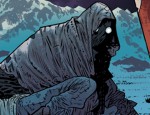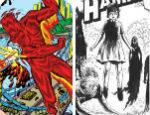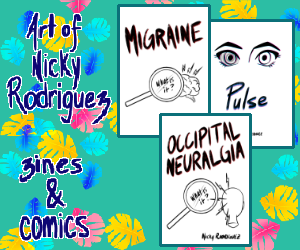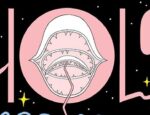As Hellboy continues to adjust to the afterlife, his journey hinges on the active participation of the reader – an incredible gesture of trust on the part of creator Mike Mignola.
When Hellboy in Hell debuted, it marked the return of Mike Mignola to full writing-and-art duties on the character he created back in 1993.
It was an exciting return to Hellboy’s roots that spoiled readers with four monthly installments before adopting a more sporadic publishing schedule; issue #5 came a full nine months after the initial four-issue arc. Now, another five months later, the long wait for the series’ sixth installment is over.
The primary action of this issue comes from a confrontation between Hellboy and the Vampire of Prague, a cursed soul whom Hellboy had encountered on Earth. As they fight, other damned souls discuss the history of the Vampire: a churchman and a gambler who played card games with the dead victims of the Plague, cursed with eternal life until he lost at his own game. It just so happens that, in their first meeting, Hellboy did beat him, and in his new freedom the Vampire chose to live in Hell.
The story is interesting, but – as has been the case with the series thus far – the strength of this issue has less to do with the action of its plot than it does with the incredible development of both character and world.
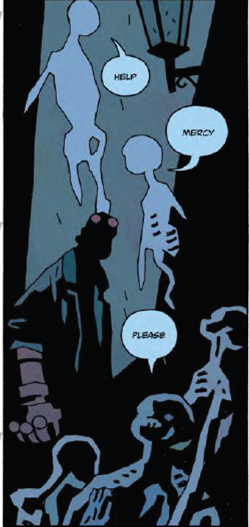 Mignola takes great care in peeling back new layers of the world with each successive issue. This particular issue begins with two cartographers discussing their attempts to map the entirety of Hell; it ends with an observation of hope within the darkness. In both cases, we learn something new about Mignola’s vision of Hell.
Mignola takes great care in peeling back new layers of the world with each successive issue. This particular issue begins with two cartographers discussing their attempts to map the entirety of Hell; it ends with an observation of hope within the darkness. In both cases, we learn something new about Mignola’s vision of Hell.
And yet, in spite of that knowledge, the specific parameters of the world remain fuzzy. The cartographers are unable to complete their map because they cannot find the way out of the city. The observation of hope makes the inhabitants of Hell as varied as those on Earth. At every turn, the things that seem at first to be revelatory are in fact obscuring the true nature of Hellboy’s situation.
Mignola is very deliberately withholding details that would make the world too concrete. His writing and artwork are at their best when he enables readers to contribute to the process of storytelling. He provides a broad notion of the geography of Hell, but does not allow us to pinpoint any one exact location. His heavily stylized art sets tone beautifully but does not provide much in the way of detail.
Reading Mignola’s work is an exercise in imagination. Working within the provided framework, he encourages the reader to bring their own interpretation to bear on the story. Hellboy’s literal history blends with the reader’s history of the character, the tangible elements of the story serving as conduits through which to explore the character and the new world he inhabits.
Creators of art often suffer from a very particular insecurity: the notion that the thing they’ve created is something only they can fully understand. The result is over-explanation – too many facts, too much exposition, too much justification – that detracts from the experience of that given piece of art.
What Mike Mignola has done with this title is a tremendous display of trust, freely offering his art to the public without explanation or justification. He trusts that an understanding of the world and the characters can be felt as much as it can be learned. Hellboy in Hell asks its audience to feel the story, making it one of the most visceral reading experiences in comic books today.
Mike Mignola (W/A), Dave Stewart (C) • Dark Horse Comics, $2.99. May 14, 2014





